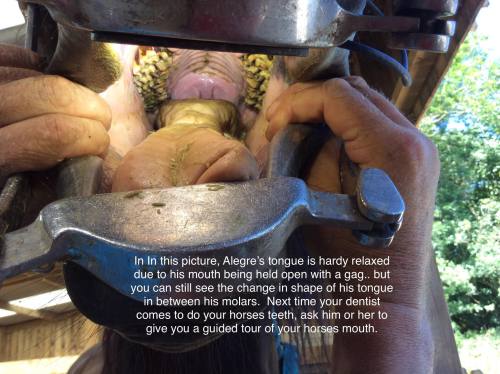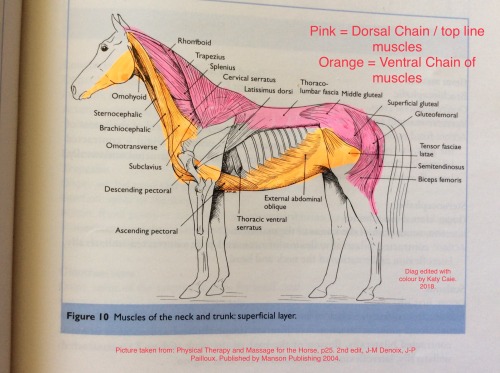Inside Your Horse’s Mouth



Understanding your horse’s working parts - inside the mouth.
The dentist came to do my horses teeth, it was the first time I’d used Paul for my horses, I’d heard good things about him being very quiet, respectful and understanding with horses, which is what you want. I explained that I was a Horse Bit Fit Consultant, and how we work and that I wanted a picture of inside my horses mouth, which I got, see below. (Pic 1 Alegre’s mouth)
My boy Alegre is a 6yr old, approx 15.3hh PRE, with a small mouth, short smile, a very large tongue. His bottom canines are in, top ones are still budding through. When looking inside his mouth, sideways on, without a dentists gag, his grass muscle / body of the tongue is very obvious to see. In the picture, you can see the change in shape of his tongue from the tip to the body of the tongue (grass muscle) in between his molars. All of this is useful to know and understand when looking at what space is available to sit a bit in the horse’s mouth.
Why did I want a picture of my boy’s mouth ? Mainly for educational reasons for myself and my clients. I see a lot of large tongued horses with obvious grass muscles on my travels with Horse Bit Fit and I am constantly explaining why this and the tongue in general is so important to the horses way of going.
So some points on the tongue:
Which you should understand and your local Horse Bit Fit consultant and a good Equine dentist will be able to explain to you:-
1. It is the largest muscle in the horses head.
2. It is connected / held in place by the hyoid apparatus.
(Pic 2 - Hyoid)
3. The tongue via the Hyoid apparatus connects into the neck via:.
- the Omohyoid muscle which originates on the inside if the scapula (shoulder)
- the Sternohyoid muscle which originates on the sternum.
- the Sternothyroid muscle which also originates on the sternum.
- These muscles are part of the Ventral Chain of muscles.
(Pic 3- Dorsal and Ventral Chains)
4. Any tension or discomfort in the tongue will affect the neck muscles and temporomandibular joint (TMJ), in turn this will affect the shoulder so blocking movement. A blocked shoulder, will in turn cause the back to hollow and block movement in the hindquarters, the abdominal muscles will not be engaged and a pot belly will form.
Tension in the tongue and jaw can be cause by:
1. Badly fitted bridle - too tight.
2. Tight nosebands - restriction of natural movement of tongue and jaw.
3. Badly fitted Bit - wrong size, and or wrong mouthpiece for horse.
4. Riders hands having too harsh / heavy or jarring / inconsistent contact.
5. Any other gadget that you use to help create an outline that causes discomfort and stress to the horse - draw reins for example.
On wanting your horse to go in an outline and take a contact, this cannot be forced, the horse has to willingly want to take a contact and will only do so if comfortable with the tack (bit, bridle and saddle) being used and the riders hands at the other end of the contact.
Paul and I were clearly singing off the same song sheet with regards to the horses tongue, hardly surprising really, and the 2nd thing we had in common was that we were both ex British Army. He had served in the Veterinary Corps, and spent time working with the Cavalry. So he told me the story of how “2 wrinkle rule”, that is used with regards to where the bit sits in the horse’s mouth, came about. The vast majority of us will have been taught this rule by the Pony Club or through BHS approved riding schools, but we will not have been taught why we use it.
The 2 wrinkle rule
The rule originates from the British Cavalry, circa the Crimean War.
An incident occurred with a Cavalry horse, whose bridle came off, and it went off at a gallop, causing mayhem and injuring some Cavalrymen. Once the horse was caught, a very angry officer, commanded that the bridle be put on tight enough so that it did not come off again, and that the bit be high in the mouth causing 2 wrinkles. All of the Cavalry horses were then bridled the same controlling way.
Horses continued to be actively used by the British Army in both WW1 and 2, and Cavalrymen on leaving the Army have influenced British horse riding in general as they would all have been highly respected as brave, knowledgeable and excellent survival riders. A high proportion of which would have became riding instructors, passing on the “2 wrinkle rule” to a wider audience.
British riding has basically evolved from the Military and Hunting field, it is survival riding. Modern day Eventing and Dressage competitions both originate from the Military, one as a test of bravery and stamina, the other of discipline and athleticism for Cavalry horses.
Only since the horse moved from Military, hunting and working horse status to being classed as a leisure and competition animal post WW2 has there been more research gone into the horses comfort with the aim of maximising its competition performance. As a result we now have a massive equine industry and market for a somewhat confusing variety of saddles, bridles and bits available. Alongside this is an ever expanding knowledge of equine anatomy and biomechanics through scientific research which is now accessible to all, but wasn’t available for the early Cavalry Horses.
Sadly the 2 wrinkle rule, originated from Cavalry tradition, with no scientific backing, has yet to die out. But any of the Horse Bit Fit Consultants can help you move away from it and towards a happier horse with a comfortable tongue, that will willingly take a contact without the need for Military command and control exerted on it.
Regards
Katy
Note: The Author is a retired Army Major, who served 20yrs in the British Army and ran a number of Military Saddle Clubs. She has a BA in Equine Science and studied equine anatomy intensively. Since retiring herself from Military Command and Control, she is passionate about training horses in a correct biomedical way in order to maximise performance and wellness of the horse.
